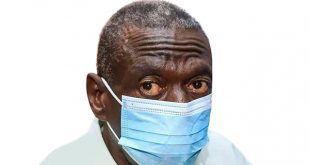
By Ronald Musoke
Experts say scaling up pneumonia interventions plus innovative diagnostic technologies are key to containing the disease
Jane vividly remembers the day her first child died sometime back. After a motorcycle ride in cold weather one evening, she realized that her baby had started developing a breathing problem. Before long, she was losing breath, as well as losing energy and consciousness.
Another ride on the motorcycle to the health centre only made matters worse. Her baby was pronounced dead on arrival at the clinic with the doctor blaming pneumonia for the death. Pneumonia – a disease that affects the lungs— is one of the leading causes of death particularly among children under five.
Research shows that about 36,000 children die each year in Uganda, and health workers say there is urgent need for targeted and effective approaches to tackle the disease at all levels of the health system.

In concerted efforts to reduce the burden of pneumonia among Ugandan children aged one to five years, the government in conjunction with development partners is launching new innovations to turn the tide.
One of the partners in the effort, Malaria Consortium Uganda— an international public health NGO working in Africa and Asia to control malaria and other common childhood diseases like pneumonia and diarrhoea by using innovative strategies and approaches— is supporting the government to implement all-inclusive programmes in the country to reduce the unacceptably high number of children who succumb to pneumonia and diarrhoea every year.
According to the United Nations Children Emergency Fund (UNICEF), Uganda is among 15 countries including Afghanistan, Angola, Burkina Faso, China, the Democratic Republic of Congo, Ethiopia, India, Indonesia, Kenya, Mali, Niger, Nigeria, Pakistan, Tanzania, which account for 53% of total episodes of diarrhoea and 56% of severe episodes, and 65% of total episodes of pneumonia and 64% of severe episodes.
One of the approaches looks at correctly diagnosing pneumonia in a timely manner according to Dr. Godfrey Magumba, the Malaria Consortium Uganda Country Director.
Dr. Magumba told journalists at a recent press conference that the need to innovate to improve the diagnosis could be important in reducing a large portion of deaths of children below five in the country.
It has been noted that the main causes of death among infants in Uganda are malaria, pneumonia, diarrhoea, neonatal conditions and HIV and as such Village Health Team members (VHTs) in approximately 34 districts across Uganda are diagnosing and treating malaria, pneumonia and diarrhoea in children under five as part of the government’s integrated community case management (ICCM) strategy.
With support from the Bill & Melinda Gates Foundation, the Malaria Consortium, through the inSCALE project, is supporting VHTs to diagnose pneumonia more effectively using an application uploaded on their mobile phones.
VHTs in eight districts of mid-Western Uganda have already received the mobile phones with a specially developed respiratory timer which allows them to easily and accurately count a child’s breathing rate and assess whether they have pneumonia.
According to Edmond Kertho, the inSCALE Project Coordinator at Malaria Consortium Uganda, a child below one year who presents symptoms of fever and cough, and breathes more than 50 times in one minute and above is most likely to be suffering from Pneumonia, while one who is above two years and breathes 40 times or more in one minute is likely to be suffering from the same ailment.
In the past, Kertho says, it has been challenging for the VHTs to count these respiratory rates but now the community health workers find it easier to use the application in comparison to the other respiratory timers on the market.
A recent World Health Organization (WHO) report says acute diarrhoeal and respiratory infections are the most frequent childhood illnesses and causes of attendance at health services in low-income and middle-income countries and despite large reductions in child mortality between 2000 and 2010, these diseases remain major causes of avoidable deaths and account for about 30% of all child deaths worldwide.
Therefore, the UN agency warns that the achievement of the fourth Millennium Development Goal and the longer-term target number three of reduction of child mortality to 20 deaths or fewer per 1000 live births in all countries by 2035 will necessitate substantial decreases in mortality from the two illnesses.
Pneumonia is increasingly becoming a global concern. According to one report in the medical journal, The Lancet, on the global burden of childhood pneumonia and diarrhoea published in April, diarrhoea and pneumonia remain the leading infectious causes of death in children younger than 5 years, and caused an estimated 700, 000 and 1·3 million deaths, respectively, in 2011.
Over 70% of deaths associated with diarrhoea and 81% of those associated with pneumonia happen in the first two years of life, suggesting that an increased emphasis on prevention and treatment in neonates and children younger than 2 years is crucial, the report noted.
Although the greatest proportions of severe episodes of diarrhoea and pneumonia were in the Southeast Asian (26% and 39%, respectively) and African regions (26% and 30%, respectively), the highest number of childhood deaths were in sub-Saharan Africa, where 50% of deaths from diarrhoea and 43% of deaths from pneumonia occurred in 2011.
Pneumonia and diarrhoea have long been regarded as diseases of poverty and are closely associated with factors such as poor home environments, under nutrition and lack of access to essential services and deaths due to these diseases are largely preventable through optimal breastfeeding practices and adequate nutrition, vaccinations, hand washing with soap, safe drinking water and basic sanitation, among other measures.
An integrated approach to tackle these two killers is essential, as many interventions for pneumonia and diarrhoea are identical and could save countless children’s lives when delivered in a coordinated manner.
UNICEF says an equitable approach could save more than two million children’s lives by 2015 and the potential for saving lives by scaling up the proper interventions.
Modeled estimates suggest that by 2015, more than two million child deaths due to pneumonia and diarrhoea could be averted across 75 countries with the highest mortality burden if national coverage of key pneumonia and diarrhoea interventions were raised to the level in the richest 20% of households in each country.
In this scenario, child deaths due to pneumonia in these countries could fall by 30%, and child deaths due to diarrhoea could fall 60%. Child health advocates have also called on manufacturers of medical devices to step up efforts to bring technologies to the market, and on donors to strengthen their support for the development and distribution of new diagnostics technologies at affordable prices particularly in poor countries in Sub-Saharan Africa.

Facts on Pneumonia
- Pneumonia is the leading cause of death in children worldwide
- Pneumonia kills an estimated 1.1 million children under the age of five years every year – more than AIDS, malaria and tuberculosis combined
- Causes
- Pneumonia is caused by a number of infectious agents, including viruses, bacteria and fungi
- Streptococcus pneumonia is the most common cause of bacterial pneumonia in children, followed by Haemophilus influenzae type B (Hib)
- respiratory syncytial virus is the most common viral cause of pneumonia
- in infants infected with HIV, Pneumocystis jiroveci is one of the commonest causes of pneumonia, responsible for at least one quarter of all pneumonia deaths in HIV-infected infants
Transmission
- Pneumonia can be spread in a number of ways; the viruses and bacteria that are commonly found in a child’s nose or throat can infect the lungs if they are inhaled
- They may also spread via air-borne droplets from a cough or sneeze. In addition, pneumonia may spread through blood, especially during and shortly after birth.
Symptoms
- Symptoms of viral and bacterial pneumonia are similar; however, the symptoms of viral pneumonia may be more numerous than the symptoms of bacterial pneumonia
- In children under five years of age, who have cough and/or difficult breathing, with or without fever, pneumonia is diagnosed by the presence of either fast breathing or lower chest wall in-drawing where their chest moves in or retracts during inhalation
- Wheezing is more common in viral infections
- Very severely ill infants may be unable to feed or drink and may also experience unconsciousness, hypothermia and convulsions
Risk factors
- Malnutrition or undernourishment especially in infants who are not exclusively breastfed
- Pre-existing illnesses, such as symptomatic HIV infections and measles, also increase a child’s risk of contracting pneumonia
- Indoor air pollution caused by cooking and heating with biomass fuels (such as wood or dung)
- Living in crowded homes
- Parental smoking
Prevention
- Immunization against Hib, pneumococcus, measles and whooping cough (pertussis) is the most effective way to prevent pneumonia
- Adequate nutrition is crucial to improving children’s natural defenses, starting with exclusive breastfeeding for the first six months of life
- Addressing environmental factors such as indoor air pollution (by providing affordable clean indoor stoves, for example) and encouraging good hygiene in crowded homes also reduces the number of children who fall ill with pneumonia
- In children infected with HIV, the antibiotic cotrimoxazole is given daily to decrease the risk of contracting pneumonia
(Source: World Health Organisation)
 The Independent Uganda: You get the Truth we Pay the Price
The Independent Uganda: You get the Truth we Pay the Price


